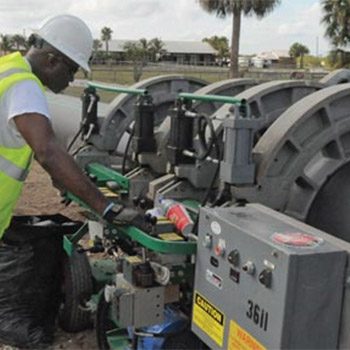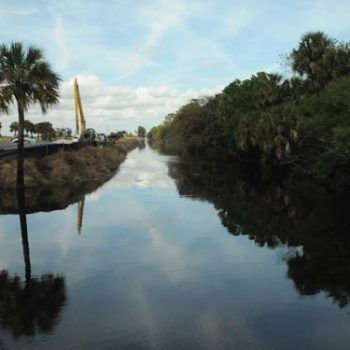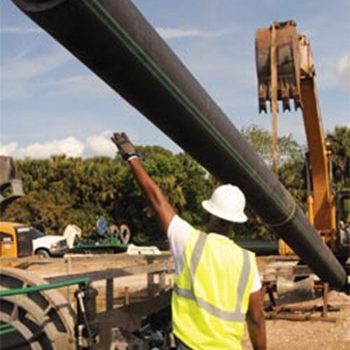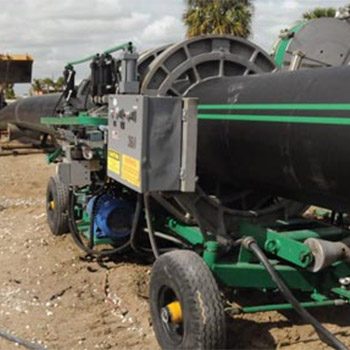Many Floridians and other Americans may take for granted the lagoons that contribute to the nation’s ecosystems. However, Florida’s Indian River County has found a solution using directional boring and water treatment technologies to rehabilitate the second most polluted section of the 154-mile-long Indian River Lagoon. The entire lagoon stretches along the eastern coast of Florida, from just north of New Smyrna Beach south to Fort Pierce.
Pollution of Indian River County’s portion of the lagoon began 80 years ago, when a vast canal system was created to drain more than 50,000 acres of marshland. The canal system now discharges huge quantities of stormwater runoff and groundwater seepage into the lagoon through three large relief canals. The canal system’s purpose was to make the county more attractive to farmers and other commercial ventures by making the land suitable for farming and development.
However, eight decades later, it is that very farming and development that is hurting the final drainage point for the canals — the Indian River Lagoon. The stormwater runoff and groundwater seepage is contaminated with nitrogen and phosphorus from fertilizers used on farms and residential developments. Those elements are washed off the land into the canals by rainfall runoff, fertilizing the aquatic plants growing in the canals. The canals eventually transport the freshwater plants into the lagoon where they die from the lagoon’s saline environment and fall to the bottom, creating muck deposits and hindering the growth of seagrass. The estimated toll of the over-fertilization is 25,000 tons of vegetative material that finds a way into the lagoon each year.
This process creates algae blooms in the Indian River Lagoon, which paired with suspended solids in the water, significantly reduce sunlight’s ability to penetrate the water column. That light is critical to the survival of seagrass in the area. Healthy seagrass coverage is a significant indicator of a healthy and diverse lagoon ecosystem.
One of Indian River County’s solutions was to remove as many of the pollutants as possible from the canal water with the creation of Egret Marsh Regional Stormwater Park.
Before the Stormwater Park could begin treating the water, a pump station was constructed along one of the nearby large canals. Officials and engineers determined that the best way to get the polluted water to the Stormwater Park was via a 700-foot pipeline installed using directional bore methods. The bore was made trickier by some of the plan’s specifications — to go at least 10 feet beneath the beds of two of the canals, as well as traveling under a road that will likely be widened in the future.
High-density polyethylene pipe (HDPE) was chosen for the project due to some of the design demands placed on the proposed pipeline. First, a gradual curve in the pipe was required so the pipeline would reach the Stormwater Park at the desired location. HDPE’s properties allow it to flex, yet remain structurally strong. Secondly, the pipe will have to stand up to the chemicals in the polluted water.
Personnel from Arrow Directional Boring Inc. fused the 24-inch DIPS SDR 11 JM Eagle polyethylene pipe with a McElroy Rolling 1236 machine from ISCO Industries along a narrow right-of-way between a fence line and one of the canals. A mechanical joint adapter was fused onto the HDPE pipe, allowing the pipe to be joined to a ductile iron force main connected to the pump station situated along the canal. Workers then continued fusing the pipe until 700 feet was completed along the narrow right-of-way. The pipe fusion process took only two days.
The pipe fusion process joins two pieces of HDPE with heat and pressure. The process begins by “facing” or shaving the pipe ends simultaneously so they can be joined together with heat to create a continuous, sealed pipeline. The welding of pipe segments is accomplished by using a Teflon-coated heater plate in contact with the pipe ends, which heats the polyethylene to a molten state. Then, after removing the heater plate, the ends are pressed together under a controlled pressure to form a weld and then cool. The resulting joint is as strong or stronger than the pipe itself. Third-party research indicates that HDPE pipe and joints can have a lifespan of more than 100 years.
Arrow Directional Boring may be Florida’s foremost directional drilling company. Vice President Jeff Blake helped found the company in 1996. Since that time, he’s accrued experience and knowledge on the art of water- and sewer-focused directional drilling, while holding leadership positions with the Underground Contractors Association of South Florida and the Underground Utility Contractors of Florida. He passes down the skill, knowledge, and best-practice techniques to employees, often requiring that they are familiar with the fusion process.
Arrow Directional Boring performed the pipe fusions, as well as the directional drilling on the project. The bore and subsequent pulling of the line through the hole was performed by a 261-horsepower Ditch Witch JT7020 HDD system. Arrow Directional Boring’s team performed the bore and pull-in over a five day period. On the first day, the team set up the rig and recycling equipment. That was followed by a day of surveying for the wire line guidance system. The third day was spent completing the pilot bore and starting the reaming process for the 24-inch pipe. The pipe was hooked into place on the fourth day, with the pipe being filled with water to give it neutral buoyancy. The final day was spent pulling the pipe into place, which was completed by dusk.
Only after the canal water is pumped to the Egret Marsh Stormwater Park will treatment begin. In the first treatment step, the water will run across an algal turf scrubber (ATS), which is a very large, gently sloped surface overlaid with a rough grid-like material placed onto a plastic geomembrane. Nutrient-rich water will then flow over the ATS surface where dense mats of algal turf will grow over time to be harvested at a later date. The harvested algae is then composted or mixed with other material and fed to cattle.
The original algal turf scrubber technology was developed by Dr. Walter Adey, director of Marine Systems Laboratory at the Smithsonian Institute in Washington D.C. The original use was to remove polluted waste from saltwater aquariums. Since then, the ATS system has proven an excellent way of removing nitrogen, phosphorus and a variety of other pollutants found in water and stormwater. The patent for the ATS system is owned by Hydromentia Inc.
Algae harvesting is performed with an all-terrain vehicle or tractor pulling a scraper. The dislodged algal turf will wash into a collection trough and be removed by an automatic rake at a harvesting station. Previous uses of the system have shown that a single operator can harvest up to an acre of algae per hour, resulting in a harvest of about five wet tons. The protein content is generally around 30 percent, making it perfect for reuse as animal feed. Besides using the harvested algae for compost and cattle feed, Egret Marsh will research other uses for the nutrient-rich algae.
After harvesting, the water will move through three interconnected polishing ponds that will remove algal material that escapes the turf scrubber, as well as residual nutrients and remaining solids. Old “borrow” pits will be modified into the polishing ponds and each will hold populations of fish, insects, waterfowl and other animals. The ponds’ water will also provide storage for potential water use by others.
Cleaning up the Indian River Lagoon will produce many beneficial effects for the area. A healthier lagoon will increase fish production and recreational activities.
While the recuperation of Indian River County’s portion of the lagoon will be helpful to a variety of parties, the endangered Wood Stork might be getting the most out of the Egret Marsh Stormwater Park. The final polishing pond will be operated and managed to attract the Wood Storks to a safe and well-stocked wetland environment. The only stork that presently breeds in North America, the Wood Stork has small populations in Georgia, Florida and South Carolina.
Indian River County plans to turn the wood stork habitat, the Stormwater Park’s aquatic plant-based stormwater treatment systems, and revamped environment into educational platforms for the public.





